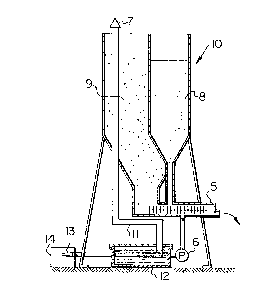Une partie des informations de ce site Web a été fournie par des sources externes. Le gouvernement du Canada n'assume aucune responsabilité concernant la précision, l'actualité ou la fiabilité des informations fournies par les sources externes. Les utilisateurs qui désirent employer cette information devraient consulter directement la source des informations. Le contenu fourni par les sources externes n'est pas assujetti aux exigences sur les langues officielles, la protection des renseignements personnels et l'accessibilité.
L'apparition de différences dans le texte et l'image des Revendications et de l'Abrégé dépend du moment auquel le document est publié. Les textes des Revendications et de l'Abrégé sont affichés :
| (12) Demande de brevet: | (11) CA 2029847 |
|---|---|
| (54) Titre français: | CHAUFFE-MORTIER |
| (54) Titre anglais: | HEATER FOR A MORTAR PREPARATION SYSTEM |
| Statut: | Réputée abandonnée et au-delà du délai pour le rétablissement - en attente de la réponse à l’avis de communication rejetée |
| (51) Classification internationale des brevets (CIB): |
|
|---|---|
| (72) Inventeurs : |
|
| (73) Titulaires : |
|
| (71) Demandeurs : | |
| (74) Agent: | KIRBY EADES GALE BAKER |
| (74) Co-agent: | |
| (45) Délivré: | |
| (22) Date de dépôt: | 1990-11-13 |
| (41) Mise à la disponibilité du public: | 1992-05-14 |
| Requête d'examen: | 1997-11-13 |
| Licence disponible: | S.O. |
| Cédé au domaine public: | S.O. |
| (25) Langue des documents déposés: | Anglais |
| Traité de coopération en matière de brevets (PCT): | Non |
|---|
| (30) Données de priorité de la demande: | S.O. |
|---|
ABSTRACT
This invention describes a heating system for use with a
mortar mixing unit. The heating system is comprised of a
series of heat exchanging portions used to inhibit freezing of
the materials used to prepare mortar in extremely cold weather
conditions. The first heat exchanging portion is used to heat
the water used to mix mortar. The second heat exchanging
portion is used to warm the mixing unit, which contains the
water, aggregate, and sand. The third heat exchanging portion
is used to warm the aggregate, which is contained in a silo.
Note : Les revendications sont présentées dans la langue officielle dans laquelle elles ont été soumises.
Note : Les descriptions sont présentées dans la langue officielle dans laquelle elles ont été soumises.

2024-08-01 : Dans le cadre de la transition vers les Brevets de nouvelle génération (BNG), la base de données sur les brevets canadiens (BDBC) contient désormais un Historique d'événement plus détaillé, qui reproduit le Journal des événements de notre nouvelle solution interne.
Veuillez noter que les événements débutant par « Inactive : » se réfèrent à des événements qui ne sont plus utilisés dans notre nouvelle solution interne.
Pour une meilleure compréhension de l'état de la demande ou brevet qui figure sur cette page, la rubrique Mise en garde , et les descriptions de Brevet , Historique d'événement , Taxes périodiques et Historique des paiements devraient être consultées.
| Description | Date |
|---|---|
| Inactive : CIB expirée | 2022-01-01 |
| Inactive : CIB de MCD | 2006-03-11 |
| Demande non rétablie avant l'échéance | 2001-07-30 |
| Inactive : Morte - Aucune rép. dem. par.30(2) Règles | 2001-07-30 |
| Réputée abandonnée - omission de répondre à un avis sur les taxes pour le maintien en état | 2000-11-14 |
| Inactive : Abandon. - Aucune rép dem par.30(2) Règles | 2000-07-28 |
| Inactive : Dem. de l'examinateur par.30(2) Règles | 2000-01-28 |
| Lettre envoyée | 1997-11-28 |
| Inactive : Renseign. sur l'état - Complets dès date d'ent. journ. | 1997-11-28 |
| Inactive : Dem. traitée sur TS dès date d'ent. journal | 1997-11-28 |
| Exigences pour une requête d'examen - jugée conforme | 1997-11-13 |
| Toutes les exigences pour l'examen - jugée conforme | 1997-11-13 |
| Demande publiée (accessible au public) | 1992-05-14 |
| Date d'abandonnement | Raison | Date de rétablissement |
|---|---|---|
| 2000-11-14 |
Le dernier paiement a été reçu le
Avis : Si le paiement en totalité n'a pas été reçu au plus tard à la date indiquée, une taxe supplémentaire peut être imposée, soit une des taxes suivantes :
Veuillez vous référer à la page web des taxes sur les brevets de l'OPIC pour voir tous les montants actuels des taxes.
| Type de taxes | Anniversaire | Échéance | Date payée |
|---|---|---|---|
| TM (demande, 7e anniv.) - petite | 07 | 1997-11-13 | 1997-11-12 |
| Requête d'examen - petite | 1997-11-13 | ||
| TM (demande, 8e anniv.) - petite | 08 | 1998-11-13 | 1998-11-12 |
| TM (demande, 9e anniv.) - petite | 09 | 1999-11-15 | 1999-11-15 |
| TM (demande, 2e anniv.) - générale | 02 | 1992-11-13 |
Les titulaires actuels et antérieures au dossier sont affichés en ordre alphabétique.
| Titulaires actuels au dossier |
|---|
| FRAMIX CANADA INC. |
| Titulaires antérieures au dossier |
|---|
| ALLEN A. NEUFELDT |
| BRYAN KIESWETTER |